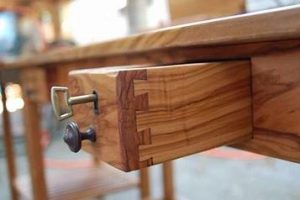Joinery is the high detail functional aspects inside a construction that are frequently fixed onto the framework. These may consist of benches, substantial wood closets and cabinets. Usually, in its most basic form, joinery consists of how two or more wooden parts are glued or nailed together. This is traditionally achieved through staining, bonding or gluing. The various techniques and materials used for Adelaide joinery must be appropriately chosen to provide maximum strength, durability, and aesthetic appearance.
 For example, there are different types of joinery for cabinet and kitchen work. There are cabinets which may be fixed with nails or screws, and these are referred to as fixings. On the other hand, there are also cabinets supported by a tongue-and-groove system, which are called smooth joints. The same is true for kitchen work areas, which may be joined using tenon joints or tongue-and-groove glues and screws.
For example, there are different types of joinery for cabinet and kitchen work. There are cabinets which may be fixed with nails or screws, and these are referred to as fixings. On the other hand, there are also cabinets supported by a tongue-and-groove system, which are called smooth joints. The same is true for kitchen work areas, which may be joined using tenon joints or tongue-and-groove glues and screws.
Tenon is one of the earliest types of Adelaide joinery because it was initially used in cabinet making. However, other joinery options have evolved such as mortise and tenon, grooved and chiselled, dovetail joinery, cross-linking and fitted joinery. Moreover, as kitchen work continues to advance so has the type of joinery that can now be found in modern kitchens.
One of the prime examples of modern wood joinery comes from the use of laminate wood veneer. Laminated wood veneer is commonly used to improve the appearance of existing wooden furniture and to create new furniture, which is appealing. A significant advantage of this type of joinery is that it provides wood veneers with similar natural wood properties. The veneer should be installed correctly to match the existing grain structure of the wood and the grain patterns in the laminated material to get the best results.
The advantages of using laminated wood veneer joinery in cabinetwork are that it provides a natural wood grain pattern that matches the cabinet’s existing look and closely resembles the grain structure of solid timber. In addition to being highly functional and visually appealing, it also offers durability and stability required for high-impact use in high-volume assembly operations. However, the main disadvantage of using this form of joinery is that the laminate material is not strong enough to withstand high tension and high temperatures. Besides, the cost of installing laminates can be relatively high due to their labour-intensive nature.
Miter saw it is one of the most used wood Adelaide joinery tools. It is particularly suitable for cutting cross boards, for instance, in horizontal and vertical ways. A cross-board is a board with at least two pieces of wood glued or nailed to a single piece of board and secured with joint fasteners. To fix a mitre saw to a board, you need to remove at least one end of the saw blade by pulling it towards you while turning the edge at an angle. Then, slide the knife right into the corner of the cross board until it fits.